
Olaparib Plus Chemo May Not Improve Outcomes vs Chemo Alone in BRCA Wild-Type TNBC
Patients with BRCA wild-type triple-negative breast cancer treated with olaparib on a gap schedule with chemotherapy did not experience improved responses compared with chemotherapy alone in the neoadjuvant setting.
Patients with basal-like BRCA wild-type triple-negative breast cancer (TNBC) who were treated with olaparib (Lynparza), given on a gap schedule in addition to carboplatin and paclitaxel, did not have improved pathologic complete response (pCR), event-free survival (EFS), or overall survival (OS) rates when compared with carboplatin and paclitaxel alone in the neoadjuvant setting, according to data presented during the 2024 AACR Annual Meeting.1
Findings from the prospective, phase 2/3 PARTNER trial (NCT03150576) showed that differences in pCR rates were not statistically significant for patients treated with olaparib (n = 281) vs patients treated with chemotherapy alone (n = 269; ∆ -1.3%; 95% CI, -9.7% to 7.0%; P = .753); rates at surgery (yT0/ypTisN0) were 51.1% vs 52.4%, respectively. The 36-month EFS rates were 80% vs 79% (log-rank P > .9) and the 36-month OS rates were 90% vs 87% (log-rank P = .8), respectively.
“[When] looking at the survival endpoints by pCR in this triple-negative wild type cohort, pCR shows a strong association with long-term outcomes,” Karen Pinilla Alba, MD, a medical oncologist and a clinical researcher in the Department of Oncology at the University of Cambridge Cancer Research, UK Cancer Centre, said in a presentation of the data. “Patients with a pCR achieved a 36-month PFS of 90% vs a 36-month PFS of 70% in those who did not achieve pCR; this difference was statistically significant. Similarly, more deaths were observed in the non-PCR group with a 36-month OS of 83% [seen] for those who did not achieve a pCR compared with 96% for patients who achieved pCR.”
Alba also noted that these data showing a lack of improvement in pCR, EFS, and OS rates were “in sharp contrast to the BRCA-mutated cohort.” However, she added that, “the gap schedule regimen provides a biologically relevant concept that should be considered when testing future PARP inhibitor combinations.”
Additionally, the pCR rates were 65.0% in tumor infiltrating lymphocytes (TILs) of at least 60% group vs 47.9% in the TILs less than 60% group (∆ 17.2; 95% CI, 7.2%-26.5%; P < .001).
Design of the PARTNER Trial
The open-label, 3-stage trial, enrolled patients with TNBC who had estrogen receptor [ER]–negative, HER2-negative, or germline BRCA wild-type disease with any hormone status. Stage 1 (n = 75) evaluated safety and stage 2 (n = 159) was the preplanned selection of the research arm examining safety, efficacy, and compliance/convenience. Stages 1 and 2 randomly assigned patients 1:1:1 to the control arm of carboplatin and paclitaxel; the combination gap-schedule arm of carboplatin and paclitaxel plus olaparib on days 1 to 14; or the combination non-gap schedule arm of carboplatin and paclitaxel plus olaparib on days 2 to 10. Anthracycline-based chemotherapy and surgery followed.
Following the first 2 stages, the combination non-gap schedule arm was dropped, and patients received the chemotherapy combination with or without olaparib on days 3 to 14 followed by anthracycline-based chemotherapy and surgery. Patients enrolled also had TILs. Further, the primary end point of the study was pCR and secondary endpoints included EFS and OS.
“PARTNER is the first clinical trial to test the combination of olaparib in combination with platinum containing chemotherapy in the neoadjuvant setting of selected with basal-like BRCA wild-type TNBC,” Alba noted.
Patients were enrolled from September 2016 to December 2021, and in the modified intention-to-treat population, the median age was 49.6 years (range, 23.9-70.9) in the gap schedule olaparib arm compared with 48.4 years (range, 23.2-71.0) in the chemotherapy alone arm. Most patients were post-menopausal (64.6% vs 62.5%), had an ECOG performance status of 0 (92.5% vs 95.9%), had TILs less than 60% (76.5% vs 78.4%), and did not have histopathological involvement of axillary nodes (66.9% vs 69.9%), respectively. Patients in the gap schedule olaparib arm vs chemotherapy alone arm had a HER2 immunohistochemistry status of 0 (82.9% vs 81.8%), 1 (10.0% vs 8.9%), or 2 (7.1% vs 9.3%), respectively.
Turning to Additional Data, Safety, and Next Steps
“Subgroup analysis didn’t show any differences among age, tumor size, [and] histopathological involvement of lymph nodes and TILs. pCR by TILs was consistent with what has been reported previously,” Alba said. “[There were] no significant differences in pCR rates in each TILs group between the research and control [arms].”
Further, grade 3 or higher adverse effects (AEs) occurred in 64.2% of patients in the olaparib arm compared with 58.7% in the chemotherapy alone arm. Serious AEs occurred at rates of 34.0% vs 34.6% and were attributed to carboplatin (21.3% vs 18.2%), paclitaxel (22.3% vs 17.5%), and olaparib (16.0% vs not applicable), respectively. In the olaparib arm, 7.4% of patients discontinued treatment due to toxicity vs 8.2% in the chemotherapy arm. Additionally, red blood cell transfusion was required in 51.4% vs 30.5% of patients during chemotherapy, respectively.
“What are the next steps?” Hope S. Rugo, MD, FASCO, of the University of California, San Francisco (UCSF) Helen Diller Family Comprehensive Cancer Center, asked in a discussion of the data. “For TNBC, it’s critical that we have further characterization of a potential set of biomarkers to determine response in this larger population where we run out of treatment options and face difficulties. Also, combinations with immunotherapy, potentially in the post-neoadjuvant setting, are quite intriguing.”
Alba added that TNBC heterogeneity is going to be further investigated by the PARTNER Trial Consortium.
Reference
Abraham JE, Pinilla K, Grybowicz L, et al. PARTNER trial: Neoadjuvant olaparib in triple-negative breast cancer (TNBC). Presented at: 2024 AACR Annual Meeting; April 5-10, 2024; San Diego, CA. Abstract CT012.
Newsletter
Knowledge is power. Don’t miss the most recent breakthroughs in cancer care.

















































































